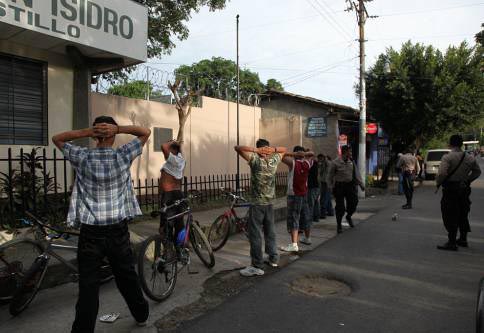Return to El Salvador is essentially a call to arms, in the best sense, to the world to not forget this hard-scrabble Central American nation whose civil war, seemingly continued long after peace was negotiated in 1992.
The film, created with the One Horizon Foundation, is well-shot and contains some searing elements that will keep your eyes on the screen. It is more of a community activist film than a documentary. Of note is that it bears occasional narration by the peerless Martin Sheen — long a union activist and all-round humanist. (When Sheen and his son Emilio Estevez were in Toronto for the film festival in September, they walked the picket lines with striking hotel workers).
The director — Jamie Moffett — had the staggering task of including the country’s history, civil war events and post-war environment into a tight 67 minutes. There were times when I thought elements of an even better documentary were buried in Return to El Salvador. There are many focuses in this film and sometimes, its impact was lost.
The keys to the film are three couples: Americans Betsy and Ron Morgan — who have spent much of their lives helping El Salvadoran refugees — Sonia and Luis Ramos who fled their country to the U.S. due to Luis’ union activities and the church couple Ruth and Alex Orantes, who provide much of the film’s emotional core. I would have been content just follow the story of Ruth and Alex. Through the three pairs, we unlock various aspects of the nation’s story.
The impetus for the film begins in March 15, 2009 when the country elected FMLN leader, and former journalist, Mauricio Funes, as its president. Admittedly, I had no idea what a watershed moment it was for El Salvadoran. The FMLN was the main rebel group fighting the right-wing government for 17 years. Even after 1992, El Salvadorans suffered under a corrupt government and dangerous times — de-listed soldiers formed gangs and became, once again, death squads.
According to the film, five people a day were dying during the civil war but post-war, it rose to about 12 per day. Peace was a paper promise.
When the film gets going, you are yanked back to those headlines back in the 1980s — death squads, assassinations of union leaders and priests and massacres of civilians. Thousands of people simply disappeared. Some 75,000 people died during the 12-year struggle.
“The only way to survive was to leave the country or go up to the mountains to join the fight,” said Alex, who did just that and became an FMLN rebel.
Canadian mining company story worth another doc
The suffering endured by the El Salvadorans is unspeakable. The stories recounted by Alex and Ruth Orantes are raw and revolting. Ruth saw a young girl grabbed by a soldier and thrown in front of a tank. Alex’s five friends were picked up off the street by soldiers and within two blocks, their desecrated bodies were dumped back on the street.
The film is cut into parts, starting first with a rapid run-through of the country’s political history, then weaving in the separate stories of the three couples. Eventually, the Ramos’s return to their homeland and meet up with Ruth and Alex Orantes. In their return, we hear their personal stories but more importantly, we also get a glimpse to the challenges facing the country.
As a Canadian, the story of mining giant Pacific Rim and its fight with the El Salvadoran government and people to unearth gold is one blazing story that merits its own documentary treatment. By the way, one of the anti-mining activists was found dead at the bottom of a well last June. An accident, according to the police, but independent medical examiners discovered that Marcelo Rivera had asphyxiated.
The FMLN’s tenure is still young. As Ruth emphasizes, she wants to see free healthcare, good education provided for all and for all citizens to have a solid roof over their heads.
The film, in its second-to-last segment, highlights the work of local women who are making a difference: a doctor who opened a community clinic, a mayor and a leader of a sustainable agriculture organization.
Tacked on at the end is a diatribe against the School of the Americas, located in Georgia. It is the place where the American military taught some of the most brutal military leaders of Latin America. Its location at the end of the film is jarring and should have been inserted earlier — perhaps when we hear about those horrible stories of killings.
Overall, the film is a pretty good chronicle of El Salvador’s bloody history. It’s also got some terrific animation segments and segues in addition to a well-composed score.
For those who don’t know much and for those who have followed El Salvador’s evolution, the documentary is worth a night out, especially with the Philadelphia-based filmmaker making appearances in some places across Canada.
As Ruth Orantes urges: “We want [people] to walk with us and hear our stories.”
For more information
On photos, click here.
Screenings:
Toronto — Carlton Cinema — October 8
Special Screening with Q&A at 7:30pm with director Jamie Moffett in attendance
Mississauga — Ciné-Starz — October 8
Halifax — Empire 8 Park Lane — October 15
Vancouver — Empire Granville — October 16
Special Screening with Q&A at 6:45pm with director Jamie Moffett in attendance
Edmonton — Princess Theatre — date TBC.
London — Hyland Cinemas — date TBC.



